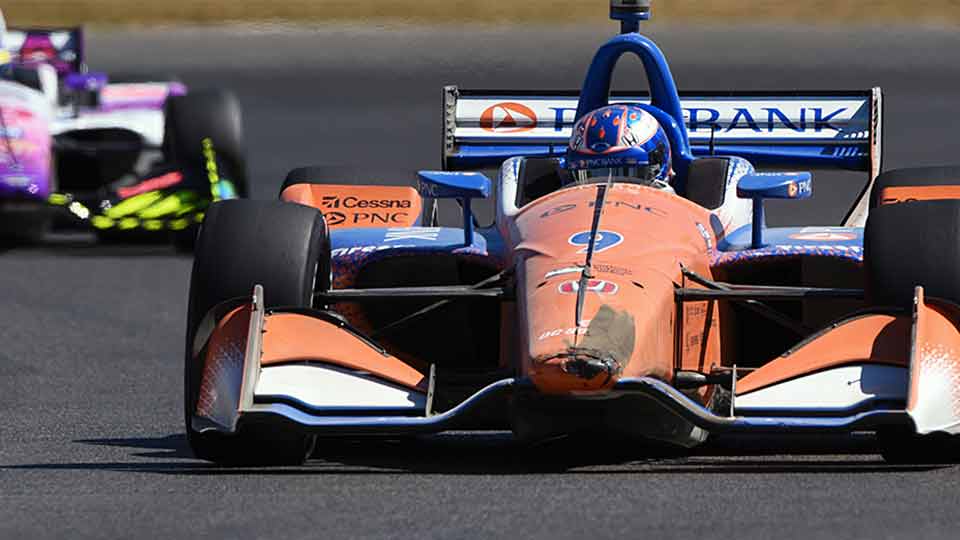PORTLAND, Oregon — All Scott Dixon could see was dirt flying. He feared the worst, that his race and possibly his Verizon IndyCar Series points lead in pursuit of a fifth season championship were lost in a first-lap cloud of dust.
“I felt like I wanted to cry for a little bit, actually,” Dixon said of blindly navigating his No. 9 PNC Bank Chip Ganassi Racing Honda in despair during Sunday’s first lap of the Grand Prix of Portland.
But when the smoke cleared from an incident just beyond Turn 3 that involved six other cars, Dixon’s front left suspension was just slightly bent and he could still drive the car.
That he did, surging from 21st place to finish fifth at Portland International Raceway. In the process, Dixon actually widened his lead in the standings by three points, to 29, on Andretti Autosport’s Alexander Rossi with a single race to go. The double-points INDYCAR Grand Prix of Sonoma shapes up as a showdown between the two drivers after Team Penske’s Josef Newgarden and Will Power dropped farther back in the pursuit, to 87 points each.
“I definitely thought it was over before it began,” Dixon said. “That old saying, ‘Better lucky than good,’ that definitely played out today. I knew it was going to be a pretty lucky day from that point on.”
After qualifying 11th on Saturday, Dixon had a premonition that there would be trouble in or around the "interesting" first turn of the 1.964-mile permanent road course. He wasn’t far off as James Hinchcliffe and Zach Veach touched after Hinchcliffe ran over the curbing in Turn 3, starting a pileup that also collected Graham Rahal, Marco Andretti and Ed Jones.
The race essentially ended for Andretti, Jones and Rahal. Hinchcliffe ran later but exited early. Yet Dixon somehow endured.
“That’s what a champion drives like,” team owner Chip Ganassi said. “It was incredible. He just did a great job. He didn’t let that thing in Turn (3) bother him like it did the rest of us.”
Watching Dixon’s on-board monitor from pit road, Ganassi managing director Mike Hull couldn’t tell what was happening.
“You want the dirt to clear so you can see what’s going on,” Hull said. “We could see the car was still running, but we couldn’t see the condition of the car here in the pit box.
“It worked out. The safety guys moved their truck for him, so he got out before being lapped, which was a big help for us. You know what? Maybe starting from the back on the restart wasn’t such a bad thing because it aided our strategy to get to where we ended up today.”
Dixon said he sustained a hard enough hit from the rear that he was convinced the race was finished.
“I was hit pretty hard, actually,” he said. “Luckily, I pulled the clutch. Once the dust cleared, I didn’t think there was going to be a left-front wheel on it. I looked and the wheel was there.”
He put the car in reverse and pulled through the other disabled cars.
“I couldn’t believe the thing was driving,” Dixon said.
His radio wasn’t functioning properly and the car’s steering was off because of that bent suspension, but he wasn’t out of contention.
Rossi was leading the race and in position to take the points lead at that early juncture. But he eventually got caught by a second caution flag late and finished eighth.
Dixon still had to overcome one more obstacle when assessed a drive-through penalty for a pit-speed violation.
“That was definitely frustrating,” the 38-year-old New Zealander said. “I thought at that point we were definitely going to be out just because I thought we were going to get lapped, but luckily the pit sequence had already started for the leaders at that point, too, so it enabled us to stay on the lead lap and then we got lucky with that caution.”
Better lucky than good, indeed. Or as Dixon would repeat later, “super lucky.”
He exhaled during a post-race NBCSN TV interview on pit road and said, “This feels like a win in these circumstances.”


























